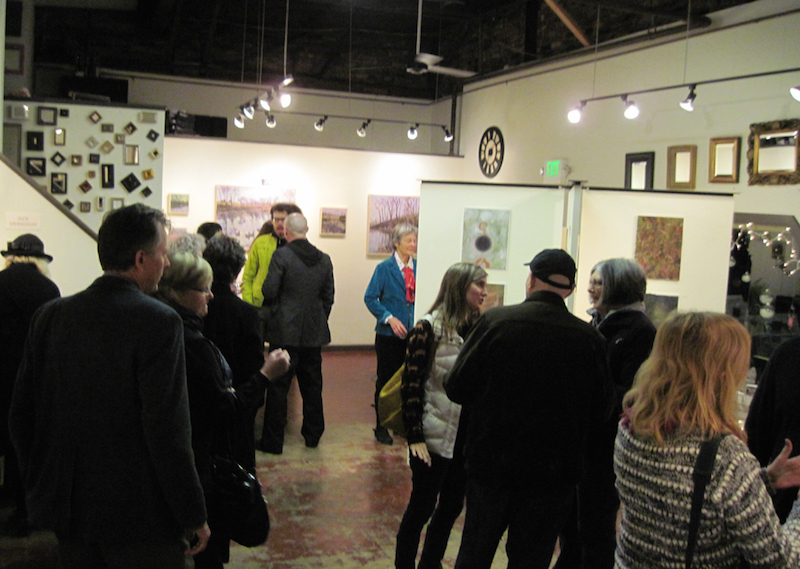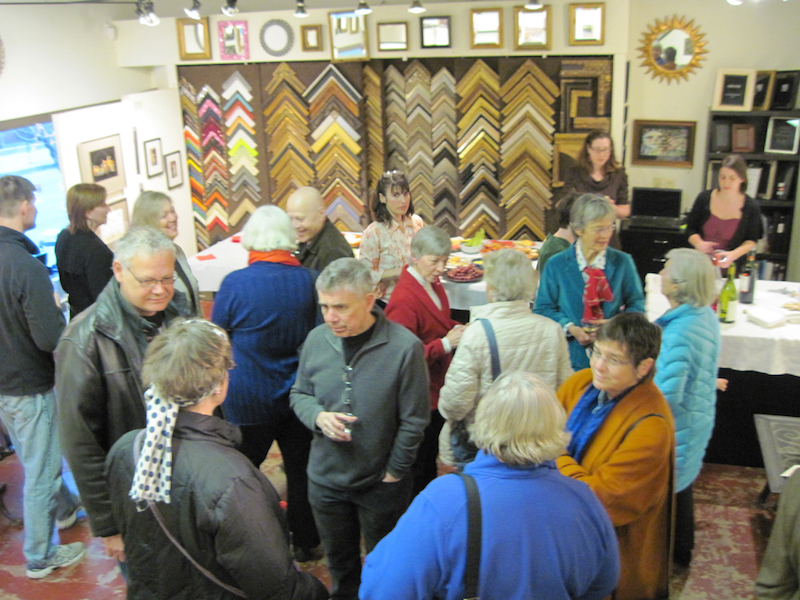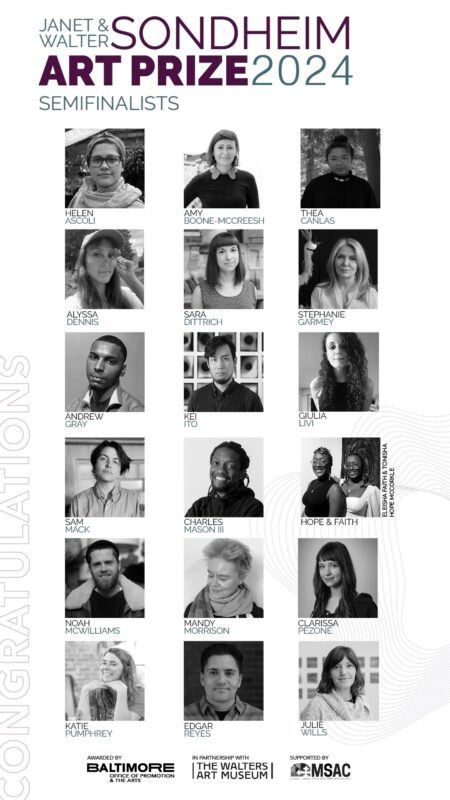An Interview with Terrie Fleckenstein, Owner of Fleckenstein Gallery & Archival Framing
By Cara Ober
I am always excited to see arts-based businesses in Baltimore succeeding, so when I read that Fleckenstein Gallery recently turned fifteen I reached out to owner Terrie Fleckenstein to ask about the secrets of her success. Located on Keswick Road in Hampden, the eponymous boutique style gallery offers archival framing services and has exhibited regional artists who work in mixed media, original prints, painting, drawing, sculpture, and ceramics. Recently exhibited artists include Erin Fostel, BmoreArt contributor Jack Livingston, Joan Erbe, Nancy Scheinman, and Dan Keplinger. Although she was busy with a large framing job, I caught up with Terrie early this fall.
When did you open Fleckenstein Gallery? Where was it originally located?
I opened Fleckenstein Gallery & Archival Framing in October of 2000, on Allegheny Avenue in Towson. Having previously worked in another contemporary art gallery, I realized I had become addicted to having the art around me. I knew many artists who were willing to fill the walls of our new little place. My intention was to become a resource where people can begin or add to their own art collections affordably.
What was your goal when you originally started it and how has it changed over the years?
The Towson location was intended to be a starter space; it was really too small to easily accommodate all of the larger pieces we would frame, and the gallery walls weren’t very roomy. Once we acquired some frame-making equipment to be more self-sufficient (especially for oversized pieces), we shared it with another woodworker in Hampden. When he decided to locate to PA, we moved the whole business to the current Hampden location on Keswick Avenue in October of 2007. The gallery space is still on the small side, but we can show much more artwork.
What is your background in the arts and education?
I received a B.A. in Psychology at Towson University. I had considered art therapy as a career, but decided against it and worked towards a second degree in Art (until Continuing Studies changed their program), and took a job at a frame shop. I always loved drawing, painting, and printmaking, though I eventually discovered that I preferred enjoying artwork by other artists who successfully accomplished what I was merely attempting to do.
I did book keeping during my first four years in college; I was always good with numbers. But framing combines my love for art, numbers and working with my hands. And I get to listen to whatever radio station I like.
I learned French matting and other decorative elements at the first frame shop, and soaked in as much as I could from the various framers that came through in my nine years there. I also liked meeting with the vendors. I had a tendency to proactively fill the void of what was lacking in production at that shop, whether it was cutting frames or doing the oversized pieces no one else wanted to do. My weakness at that time was designing with clients; I preferred to work in the back. Then I discovered that I was the best person to work with difficult clients when they requested me for other projects. They knew I was patient and just as detail-oriented as they were.
I became Director of Framing at a contemporary art gallery within a year. The framing aesthetic was very different – simple and elegant, so that one can focus on the artwork instead of the framing. (I do upon occasion have artists “complain” to me that during their shows, people commented more on the gorgeous, clean framing, than on the artwork.) Working with more original artwork, as well as very valuable and very BIG pieces, I continue to draw on various conservators as a wonderful resource to learn the proper way of framing items that would be appropriate for a museum.
In 1999, a colleague talked me into applying for the job of framing preparator at the BMA. When they called me back for a second interview, I rescinded my application with the shocking realization that despite the chance to work with art history in a magnificent institution, I actually preferred retail. (Someone later told me they were considering hiring me for the position.) I already had the opportunity to work with historical and contemporary artwork, and a great variety of items beyond the typical. Plus the clients I had were the best. I’d really miss all that.
A year later, I resigned my position from the contemporary gallery, and after much thought, I decided to open my own gallery and framing studio. Many of my previous clients had given me their business cards before I left, and word of mouth spread quickly; such is “Smaltimore”. I’m really grateful for their support in those tentative first years, getting the business off the ground and running.
Like restaurants, fine art galleries come and go. How have you been able to run this business successfully for 15 years? (Congrats!) What strategies have kept you afloat?
Thanks, Cara! I still can’t believe it – the 15 years have flown by so fast. Of course it seems that with any art venture, you need a second source of income to keep it afloat, which obviously for us is our framing studio. For others it’s a bar, a café or a mixed use space. It basically subsidizes the gallery during slow art-selling times, which sadly in Baltimore is quite often. As long as I can at least break even with it, I can still feed my addiction to be surrounded by original art, while sharing my enthusiasm for the work with others, and encouraging them to start or add to their own collections.
We have ~4-6 shows a year, and I love partnering with organizations such as the Artscape Gallery Network, and having satellite shows for the Baker Artist Awards or The Black Male Identity project, for example. It’s wonderful to be connected with other arts organizations in the community, and it certainly helps with press. I also enjoy having group shows that bring in a variety of people.
How do you select the artists you represent or show? How would you describe your curatorial aesthetic?
When my former employer closed his gallery, several of the artists asked if I would show their work. Wow, twist my arm! As with many artist-run spaces, you have a lot of artist friends and acquaintances to draw upon, so to speak. But showcasing these wonderful established regional artists really brought the gallery up a notch. One of them, Nancy Scheinman, curated several “Atelier” shows for us featuring the work of her mural assistants, emerging artists themselves.
We’ve also browsed through the Baker Artist Awards site – what a great resource! – as well as Sondheim applicants and those who have submitted artwork to various art projects for satellite shows. And sometimes I fall in love with the artwork that someone has brought in for framing. Unfortunately, my overloaded schedule won’t allow me to
venture out to shows and studios as much as I would like, so being able to view a website, some .jpegs, or perusing the Baker Artist site is really helpful.
Each gallery does have its own look, or style. I really love mixed media, and all of the variations that can come of that, as well as great drawing skills. I basically show what I want to see every day: works that are intriguing, have movement, elicit various emotions, and draw you into their worlds. And of course, this is a business, so market forces do influence some of the work I show, too. I have to pay rent for these walls!
Can you talk about the framing side of your business? How does this work alongside the gallery? Do you see them as two separate entities or do they overlap?
The framing studio and the gallery are very much linked together, as one supports the other; sometimes the framing numbers are down, and the gallery picks us up, or vice-versa. Occasionally we will frame work for an artist who is showing with us, but I don’t require it, knowing that it’s not within everyone’s means.
It has happened occasionally that a client will bring in something for framing, then fall in love with a piece on the wall and purchase that as well. Or people wander in and discover that we do framing as well as show artwork. We also have mirrors, photo frames and artful cards for quick gifts.
What’s the best part of your role in running this business? What accomplishments are you proud of?
I absolutely love following through the whole process of having a client acquire a piece of artwork from us, designing the framing, and after production, seeing the excited smile of that client when I present the framed art, especially when he or she says that it turned out even better than expected. I have the best clients!
I also enjoy that every day is different and unpredictable. You never know who will walk through that door. I spend time working with artists or clients with framing needs, then later I may be framing a print by Giacometti or Dürer (which I did a few weeks ago). Then I’ll be working on the computer, so that I can put my feet up at the end of the day.
I am proud to exhibit the work of such talented artists, and to participate with other arts organizations on various projects. But I must say, I’m most proud of having a good reputation as an archival framer. I treat every piece of art that I handle with somewhat of a reverence, whether it’s a child’s drawing or a Rauschenberg. Someone has cared enough to want this piece on the wall to relish every day, and I want to make sure it stays as close to its original condition as possible for generations.
This is also important for art collectors to ensure that their art is protected: it may wind up in a museum one day, which, indeed, has happened recently. With permission granted, I can acknowledge that I framed many of the photographs from the collection of Tom and Nancy O’Neil, who generously donated them to the BMA. The photographs are now on exhibit in the contemporary wing. It’s funny to see how these frames that are large enough for me to walk through them, look so much smaller on the massive walls of the museum. (The Pillsbury, Kellner and Morell pieces are my favorites – it’s like visiting old friends.)

What has been the most difficult thing for you? Or what was the most difficult lesson to learn?
The most difficult thing is having to say thanks but no thanks to an artist who wants to show in the gallery; this must have happened hundreds of times. It’s the worst part of my job. There are so many talented artists in the area, but not enough galleries, and I don’t have room for everyone. I do what I can to recommend other places more appropriate for their work, if it doesn’t work with our genre. I’ve been through the same thing as an artist; it’s never pleasant.
Do you think that artists make inaccurate assumptions about galleries? What would you like artists in the region to know about what you do and how you do it? If you have any advice for them, in terms of how they approach or relate to you, or other galleries, please share.
Ha, you know of course that I’m going to reference this fabulous and fun article which addresses many of the myths and misconceptions about galleries.
Mainly, people have to realize that we’re not just sitting here twiddling our thumbs waiting for someone to walk through the door. I work more hours than I care to admit to meet various deadlines, art and framing related, so I can’t just stop what I’m doing to look at the portfolio of someone who comes into the gallery unannounced. I think having a business card with a website is really important, so that I can review the artwork when I do have a few minutes, and contact the artist if I’d like to see the work in person. Having a professional attitude is most helpful, too. No one wants to work with a cranky person, or with someone who doesn’t meet deadlines.
How has a Hampden address affected your business? How do you participate in or take advantage of all the energy and new businesses opening up? Are rising rents in Hampden a potential problem for the future?
The move to Hampden was the best thing I could have done. My new address became closer to the majority of my clients, but I gained so many more new clients from the neighborhood which helped to pull me through the financial meltdown. And my fellow Hampden small business owners are the best! It’s a very funky, art-friendly place, and most people are motivated to support local businesses.
There are many events such as First Fridays, Honfest and Hampdenfest which tend to attract and keep people at “The Avenue”, 36th street. We’re on Keswick, a bit off the beaten path. But we do participate in Hampdenfest with our free-standing gold frame which is very popular – people love hamming it up in front of a camera, and we post a lot of the “portraits” on our Facebook page. We also donate photo frames to various events in the neighborhood.
It’s exciting to see all of the new businesses opening, especially down Chestnut – heading in our direction – and on our own street. This year, we’ve become a little art center on Keswick, with Make Studio and Litmore right next door, and an antique shop across the street. It’s true, the rents have gone up – mine just increased significantly, too. A developer tried to get me to move into a rehabbed space elsewhere, but this location is much more convenient for my clients. Plus, I just love this neighborhood.
Where do you see Fleckenstein Gallery going in the next 15 years?
It’s difficult to imagine that far ahead with the world changing so fast in so many ways, with globalization and social media, for example. A lot of businesses are closing their brick and mortar stores and going online. I’d like to believe that individuals would continue to peruse artwork in galleries, rather than purchasing it online from, say, Amazon. I’ll just have to adapt to the changes to keep the business afloat. Regardless, I’ll certainly attempt to have original artwork to share with the public in some capacity. We’ll need something to adorn the walls of the framing studio! That’s not going anywhere any time soon…
Terrie Fleckenstein, Owner, Fleckenstein Gallery & Archival Framing, October, 2015
Fleckenstein Gallery
3316 Keswick Road, Baltimore, MD 21211
Phone: (410) 366-3669 Fax: (410) 366-3316
[email protected]











